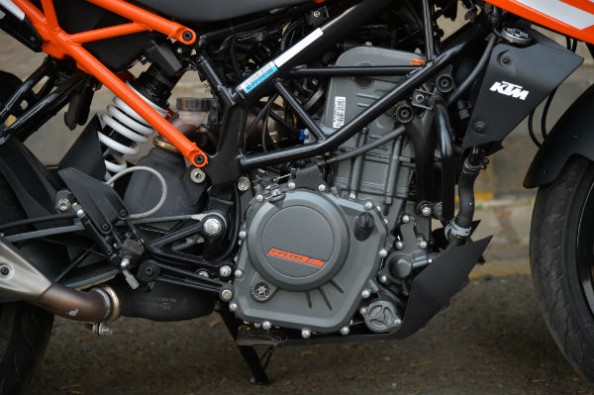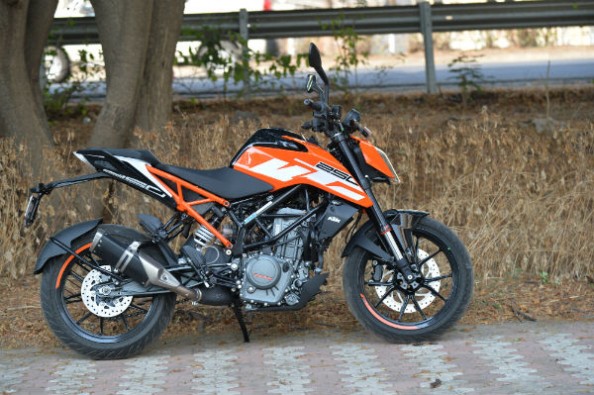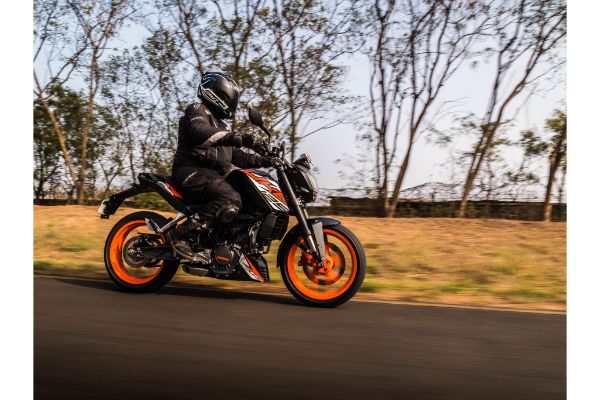The 250 Duke is a bridge between the 200 and the 390, with power, features and pricing sitting right in the middle of the two. The new bike looks like a smaller version of the 1290 Super Duke. Full of sharp lines and angles, the motorcycle certainly looks fresh.
On the outside
Up front, you have a single-unit headlamp framed by inverted devil’s horn DRLs. The bike uses the same digital instrument cluster as seen on the earlier Dukes and RCs. There’s an all-new, 13.5-litre steel tank that is contoured to provide better knee grip to riders. The tank sits on a black, exposed, steel-tube trellis frame that has been modified slightly. Bolted on to this frame is a bright orange subframe which is also all new. KTM claims, this new frame centres the weight better. The seats are also new and so is the seating position. The exhaust pipe is mounted on the side, unlike on the 200.
The new 250 is a very attractive bike - at 2,009mm in length, it is compact but still distinctive enough to draw eyeballs. The 250 Duke will be available in two colours – electric orange and white. This bike uses the same suspension setup as the 200. Stopping power is provided by a 300mm disc up front and a 230mm disc round the back. The bike also features a slipper clutch. The new KTM rides on MRF Revz-C1 tyres as the 200 – a 110/70 R17 tyre in the front and a 150/60 R17 tyre at the back.
Power Torque
The motor is a 249cc, single-cylinder, liquid-cooled engine that produces 30hp at 9,000rpm and 24Nm at 7,500rpm. The engine is mated to a six-speed gearbox that shifts in a one down, five up pattern. Get moving and, in the lower revs, until about 4,000rpm, the engine feels quite dead. That’s because the bulk of the power is concentrated in the motor’s mid-range, beyond 4,000rpm. From there on, the Duke feels punchy until its 10,500rpm redline. The 250 Duke will pull until about 115kph fairly easily; in fact, it hits 100kph in 9.02sec.
The gearbox is crisp and precise; however, we did occasionally notice the gear slip to a false neutral when shifting between third and fourth. The gearbox experience is further enhanced by the slipper clutch. The exhaust note sounds quite tinny, which might annoy you on longer rides. Vibrations are contained well by the handlebar, but they are prominently present in the foot pegs no matter what speed you are at.
From the saddle
A major problem with the engine, however, is it heating up. The combination of our traffic and the heat in Mumbai resulted in the engine heating up quite quickly. The radiator fan constantly grumbles to life in traffic. The exhaust piping leaves the engine and winds past the left flank of the bike, and this exposed portion produces tremendous amounts of heat, affecting the engine and your left ankle.
The Dukes have always been great handlers, and the 250 is no exception. Its chassis gives it impressive dynamic ability, making cornering almost intuitive. The shorter wheelbase of 1357mm, compared to the 200’s 1,367mm, makes the 250 fun to throw into multiple corners. In traffic is where the 250 Duke’s handling shone brightest - it was so easy to snake through traffic jams.
The MRF Revz-C1 tyres provide decent amounts of grip on tar roads, not so much on concrete. Stability on high speeds is alright, though the front did feel lighter and a tad unsettled over bumps at high speeds. Ride quality, on the whole, is well-balanced.
Braking is not as effective as we would have liked. The front brake lacks bite - you have to really clamp the lever down hard to pull the bike to a stop. Our braking tests revealed a 80-0kph time of 3.32sec and distance of 39.15m.
What KTM has really nailed, though, is the seating position. You are seated completely upright, without having to lean in towards the handlebars. The foot pegs too have been moved behind slightly to make for a less cramped and more comfortable riding position. So, it will do just fine on longer rides, though we strongly suggest adding a windscreen.
In the city, this bike returned 24kpl and on the highway – where we maintained a cruising speed of 80-90kph in sixth gear, the 250 Duke returned 41kpl thanks to the additional sixth gear that is optimised for cruising.
Is it worth the money?
The 250 Duke is quite the accomplished motorcycle, especially if you live in the city. It looks great, is distinctive and unique and comes with an engine with a punchy mid-range. The gearbox is precise and crisp and the handling is sublime. The upright riding position simply makes things better. At ₹1.73 lakh (ex-showroom, Delhi), the 250 Duke is a good ₹30,000 more expensive than the 200 though. If you are looking for a sporty but manageable bike to start off with, and are not exactly pinching pennies, the 250 Duke might just be what you're looking for.
















